

| Krisztina Horeczky | Main Credits, Line Four |
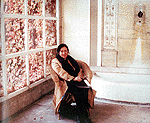 Györgyi Szakács, photo by Joseph Gallus Rittenberg 61 KByte |
Györgyi Szakács has to this date made 330 costume designs just for Hungarian theatres. She has worked in over two dozen films - the costumes of movies like Lost Illusions, Midnight Rehearsal, Daniel Takes a Train, Only a Movie, Melodrama, Three Sisters, Awakening, Magic Hunter, Jadviga's Pillow, May Day Mayhem, Bride Man and Taking Sides are all linked to her name. She received not only the prestigious Kossuth Award, but has been awarded the Theatre Critics' Prize twelve times. For the costumes in Sunshine she was nominated for an Oscar and a Genie Award. And while the Hungarian state film industry existed she was also given the Mafilm Prize. Györgyi Szakács learnt the trade as a child in her mother's couture salon in Váci Street, but from her adolescence she was only interested in theatre. As costume designing wasn't taught in those days in the college of theatre and film, she got into the profession from the outside along with a few others. She was the only one who stayed the course. After designing the exam performances of drama students, she worked with József Ruszt in Kecskemét under a contract, then joined the company of the National Theatre and finally the Katona József Theatre. She has been freelance for a few years now. Two leading personalities of Hungarian stage, Tamás Major and Imre Csiszár had a decisive effect on her career. Both in Budapest and in Kaposvár she worked in performances of great significance in the history of theatre (Three Sisters, Coriolanus, Catullus and Marat/Sade in Kaposvár). There is only one theatre in the country for which she hasn't designed any costumes. Fixing an appointment for an interview seemed impossible for weeks as my interviewee tos and fros between Vienna-Budapest and Budapest-Stuttgart. Gábor Zsámbéki is directing Oliver Bukowski's play entitled Gaste in the Theater Tri-Bühne in Stuttgart, and Tamás Ascher is putting Ostrovsky's The Forest onto stage in the Burg Theater of Vienna. Györgyi Szakács has been in the profession since 1975 and all in all four or five articles have discussed her work. She has no home page on the web and is not registered in the theatre portal. During your career you have worked with ten film-makers: Péter Gothár, István Szabó, Gyula Gazdag, Pál Sándor, György Fehér, Krisztina Deák, Judit Elek, András Jeles and on one occasion with Miklós Jancsó and Miklós Szurdi. You worked with them in theatre and you also designed costumes for their films. Among the directors mentioned there are several who, especially lately, have directed more often in theatres than from behind the camera. What are the particularities arising from the two different genres that someone who is first and foremost a theatre designer has to overcome when working in film? In films every day, every shot is a new premiere and in contrast to the theatre, the designer often works apart from the director, parallel with him. Besides this, the style of costumes also differs - on stage the picture is always what I make it to be, while in film it is what the director of photography composes. That's why the film work of a designer is full of excitement: what will fit in the picture? Will what I might consider important be visible at all? Films, though I dislike generalising, are closer in costumes to realism. Because of close-ups they demand much more detailed and meticulous work, especially let's say around the head. On the other hand judging by my experience, the designer who has a theatrical routine and has tried his strength in all kinds of performances, will generally be able to design for films too - the reverse is much less valid. Apart from your often waiting excitedly to see what and how much the camera shows, no doubt it has frequently occurred that you nothing was visible because the scene met its death on the editing table. We shot five hours' worth of material for Sunshine and roughly two hours were cut, so among others the leading actress's turn of the century café and promenading dress was left out. I can say in general that the costumes that I so anxiously awaited to see were barely or not at all visible. When I saw the film for the first time I couldn't asses my work realistically - in fact the situation is the same with stage performances too. I instinctively concentrate on, for example, whether a hat is being worn properly or not. Or what a hairdo is like. How the tie was tied. In one of the turn of the century scenes I was very annoyed by the fact that a non top-ranking actor was given a collar from the twenties. Some time always has to elapse before I can really judge a film or marvel it - even with my own work. In Hungary few people have had the chance - and even fewer will be given it - to put themselves to the test in, by our standards, high-budget, large scale productions. You and István Szabó besides Sunshine and Taking Sides, have worked together in several opera performances as well. For instance Boris Godunov premiered in Leipzig or Troubadour in Vienna. But you also designed the costumes for the Lugosi piece and the Three Sisters put on at the Opera House. Our first joint film work was Offenbach's Secret, prior to that we had only worked together on stage. I even asked him why he had thought of me. He said he asked around and several people who were important to him - among them actors as well - had recommended me and so he thought he'd offer me the task. At first I was terribly nervous and desperate to meet his ideas. The best in our joint work was that István's taste and way of thinking is very close to mine. I never had to battle with myself. Often very talented directors ask and have asked me to do something that is either alien to me or astoundingly different from what I had imagined. With István Szabó I always felt that this was the path I'd be walking along myself anyway. Following the Canadian Genie nomination you were even put up for an Oscar for the costumes of Sunshine. I didn't know anything about it. I must admit I never tried to find out how it all happened and how they noticed my work. Of course there were signs: I was nominated in Toronto for the prize for best costume and Sunshine received the award for best film. Although I considered the Toronto festival as a significant event I never for a moment supposed that I - a complete stranger from somewhere in East Central Europe - might win the Oscar. I was already touched by the Genie nomination without any expectations, but being put up for the Oscar totally astonished me. No carefully made press material on me exists. Producing these costumes in Hungary was such an enormous work that I didn't even have time to document myself on the Internet. It's a disgrace, but that's how it happened. I drew the logical conclusion that it was practically impossible that even the people who would choose me, should actually give me their votes. They knew nothing about me. Without getting entangled in the question of responsibility, tell us how you were able to work from home in this expensive international production? I got hold of the materials and collected original clothes in Hungary - except for maybe four or five costumes that I ordered from Angels in London. I never thought that I had the chance to do this, but then it eventually turned out that they were incredibly expensive and didn't even show up in the film. The Viennese Lambert Hoffer was more of a help, but considering the total amount of ready costumes it was insignificant. Along with Jennifer Ehle's clothes I had nearly all the turn of the century costumes made by the specialists I tend to work with anyway. I can't even say that I set up a large workshop because every single task was performed by someone else. How many costumes did you design? I never worked it out, but Ralph Fiennes originally had around a hundred changes of clothing. Boris Godunov was also astonishing with its six hundred costumes. The production was one of the three most spectacular German performances of 1993. With its six hundred newly made costumes! The huge-capacity workshop functioning at a very high level with an amazing human and material background was indispensable for it. Incidentally once again I was probably the last to learn about the recognition it received. It is clear that you are primarily involved in the dramatic genres which is possibly why you are so drawn towards opera. Apart from the previously mentioned operas you also worked with Tamás Ascher in Don Giovanni in Lyon, András Fehér in Un ballo in maschera, Gyula Gazdag in The Abduction from the Seraglio, Péter Vallo in Lucia de Lammermoor, Manon Lescaut and Falstaff and György Fehér in Leonce and Lena. I enjoy designing costumes precisely because of the variety and complexity. And the reason I like the dramatic genre is because it's closely linked to literature. Most recently I was taken very much by Sándor Weöres' Saint George and the Dragon as much as I was at the time by Peer Gynt or the Three Sisters. This occurs remarkably rarely. Eötvös' s Three Sisters hugely divided the audience of the Opera house, but I listened to it fascinated despite it not being a "popular" piece of music. Having designed for the Three Sisters in prose, I found it very interesting to see how the music appeared from a dramaturgic point of view in the piece. Although this isn't always apparent in my prose works, I have a strong tendency for ornamentation. This can be reproduced on the operatic stage. In prose theatre we have been making things on a shoestring recently. The most important element of your working method is for you to study the works thoroughly. You have designed epoch-making performances, but what does this really mean at the time of retranslations and characteristic, often autotelic, directorial interpretations? Without reading plays there is no rewriting either. You mentioned legendary productions. One of the most memorable performances I ever designed was the Marat/Sade in Kaposvár. (Peter Weiss's The Persecution and Assassination of Jean Paul Marat was directed by János Ács in 1981.) Partly because it was the first in the series of oeuvres that we didn't place in their own era, but instead, in this case for example, we associated it with the revolution of 1956. Not watching the performances in Western Europe I never had an archetype in my head, but had an instinctive intuition along with the director. I remember discussing this with János at Elizabeth Bridge, on the embankment. That's when he formed a vague idea of what the play actually meant to him. Television's cultural programme of the time was filming in the theatre at the first costume rehearsal and I asked them to give me a lift to Budapest. On the way back they asked me when the first costume rehearsal would be. I nearly fainted on the back seat. Did nothing come through of the clothes of the 1950s? I felt dejected, though now I presume that the members of the crew probably only saw a part of the rehearsal and maybe they had a recollection of an old performance that I had seen as a student. Despite this three or four days before the first night you could interpret what we were aiming at. Though the performance had a remarkably successful run, I'll never forget this incident. It is very difficult to lay hands on a piece with validity. Even if I am capable of replacing something for the director's sake with a more interesting design than I had originally conceived, if I don't find it logical or I can't understand it, I will refuse. I don't want to do things at all costs any more. Ten years ago in an interview you said that the training and replenishing of stage tailors and shoe-makers was unsolved. You also mentioned how few good gentlemen's and women's tailors there were. How theatres hardly have their own costume and set-manufacturing workshops. The workshop of Katona József Theatre was created at your instigation at the time. Trades have become extinct and this leaves its mark not only on theatre work but on film-making as well. Since then the situation has only got worse. The profession has lost its attraction definitively. Perhaps three Budapest theatres have workshops now. One of them is Katona, but even this is not what it used to be. Who made the clothes for Bridge Man? The former head tailor of Katona - she made most of the women's clothes - , and the men's clothes were made by Katona's gentlemen's tailor, the former dressmaking workshop of TV that has now become independent, the former National Theatre's workshop and two dressmakers from Mafilm Studio. I also had clothes made in a couture that I have used for classical costumes for some time now. Five or six tailors took part in the film. You once declared in connection with your costumes for stage that at times it's easier to produce an authentic image in the case of a classic work than a contemporary one. But however much you reconstruct an era from reproductions, reference work, picture books, photos or pattern designs, the you still have to get hold of the materials. To reconstruct a period is a big undertaking. I have read about people who are capable of copying an old item of clothing. I bow my head to those who copy or recreate something as it was. This is often necessary in films. With authentic material, authentic dyes, as the proportions and tailoring patterns were in the period. Even getting near an era is a huge task. That's why I attend auctions of paintings to encounter the figures recorded on them and to see how they vary from a late Rococo, an Empire or a Biedermeier style picture. For it's not only the hairstyles or the colour schemes that have changed. How different their mentality or manners are! Many old costumes have got damaged or were thrown out when the main store-houses closed down. So you are your own purchasing agent for materials? Exactly. Although I have help, I can't leave myself out of it. It's incredible how much I have to go after materials, and it often happens that I buy a material at my expense years ahead, because I know I'll never see it again. Not to mention collars, lace and the details on old dresses. Before the Bridge Man I bought an original dress from 1820 in Germany. Of course it was so small that no-one could get it on, but one of Crescencia's first dresses was based on it. We had to get practically all the clothes made for the principal actors. Several times we found a nice fur-lined coat for which I dyed material and had a dolman made. Authentic braiding was a big achievement too. Parallel to the shooting of the film we were making a huge amount of costumes. You have been dressing leading Hungarian and foreign actors and actresses. In your experience how much has the notion of stardom changed? Perhaps the "wearing" of stardom isn't so typical here any more. I experienced the opposite with American actors. Some of them never leave their trailers to join the "common" people at the buffet and of course they all have personal assistants. But you never know, this may be a kind of self-defence. Apparently they are expected to behave like stars. This is not something I have experienced in Hungary. Our "stars" are remarkably direct people. Do allures make your work difficult? It's interesting. These "strange" people never question my expertise. They know exactly where my place is in the hierarchy. Main credits, line four. They expect everything to go as I intend it. I have long noticed that in a Hungarian theatrical performance it is always the extra who wants to change things the most. The grounding principle of my profession is to sense what it is that an actor wants. To not only just think with the director's mind. Despite this it is often very hard. Usually I have to take care not to come up with things that will drain my energy or that are unnecessary from the start because, due to lack of money, I can't realize them anyway. I frequently have the biggest problems with myself. However absurd it sounds, you have to keep a tight hold on your imagination. Or I have to manoeuvre it so that I can realize my ideas. Because only what is on stage is valid. Nobody will sigh sympathetically in the auditorium and think: "It is like this because this is a poor theatre." I can't console myself with that. Under all circumstances, in spite of everything, you have to create what you can at the highest possible level. And this needs strength. Not only intellectual, but also physical. That's why when looking at my colleague's work I give my opinion very cautiously. It is more respect that's at work within me. Having worked in expensive productions I have also noticed that a lot of money often makes work much more elaborate. The more it costs, the more difficult our work is. Often it can be almost easier to work from practically nothing. Moreover the more people surround you, the greater the danger of not being able to carry out your original concepts. In this profession you feel - possibly actors do too - like a child at school. You always start from scratch and your completed work and achievements don't count at all. In 1989 you said: "what I have realized so far is still far from the imagined optimal top line". How much has this statement been modified by now? To the extent that I wouldn't say anything like it now. I can no longer measure my own scale. Often it is so difficult to reach a certain standard that I am glad if I can reproduce the quality that I once obtained with the odd costume. This may seem a very pessimistic thought, but that's the way it is. You achieve much less with the same amount of work. Once you said: "In the theatre I am also the DOP, I compose and show the stage." What is the world like that you want to show, or what should it be like? On no account limited. People have many different worlds. And these worlds open a window onto what I reveal of myself. I think this an honest world, issuing from inside. It's important that it should radiate something that gives you strength and bearing. I feel more and more that the task of the theatre and artists is similar to a vocation. Because you need faith, strength and a concept of the future to live. As the years pass I am more and more of the opinion that I'd like to show what it is I know and what I reject.
| 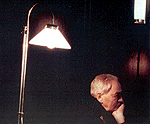 István Szabó 65 KByte
| 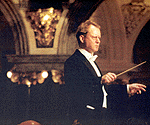 Stellan Skarsgard 84 KByte
| 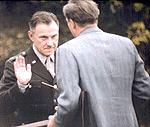 Harvey Keitel 76 KByte
| 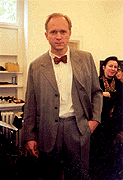 Ulrich Tukur, Györgyi Szakács 65 KByte
| 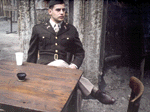 Moritz Bleibtreu 76 KByte
| 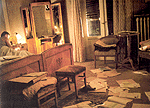 The photos has been taken by Joseph Gallus Rittenberg at the shooting of Taking Sides 79 KByte
|  96 KByte
| 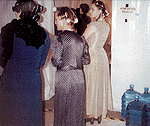 101 KByte
| 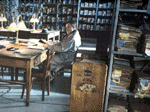 Harvey Keitel 94 KByte
| 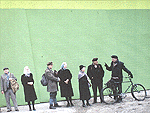 98 KByte
| 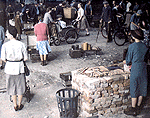 114 KByte
| 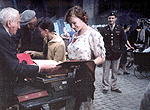 Birgit Minichmayr, Moritz Bleibtreu 75 KByte
| 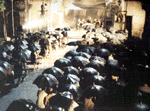 90 KByte
| 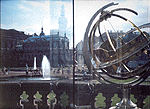 71 KByte |